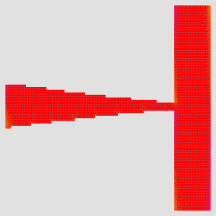Experiments on highly ordered alloys
![]()
1. Highly anisotropic nano-magnets
The study of magnetic materials constrained to very small sizes is important under both fundamental and applied points of view. One of the challenges that the magneto-recording industry faces is that the ever increasing demands for higher storage density is reaching fundamental limitations such as the super-paramagnetic limit (i.e. thermal fluctuations can "flip" the magnetization in the nano-magnets). One possibility to overcome this problem is to use nano-magnets made of materials that exhibit high magnetic anisotropy. Highly ordered alloys of FePd and FePt exhibit such strong perpendicular anisotropy.
We studied highly ordered FePd and FePt thin films, deposition conditions and post-deposition treatments to obtain the highly ordered phase. We explored new venues to obtain the highly ordered phase in nano-sized magnets. Aspects of this research were carried out in collaboration with Dr. Alfonso Cebollada from the Institute of Microelectronics in Madrid (IMM) funded by an international collaboration grant from NSF.
Our most recent activities related to this project have been funded by Phase 1: STT-RAM DSRPA-GRANDIS grant (2010). We are at present working under Phase 2 of this grant (2011-2012).
Activities and findings (2004-2009)
2. Magneto-transport in nano-contacts.
An important application of nano-magnetism that we are currently studying is domain-wall effects in the magneto-resistance of nano-structures. Preliminary studies in this area were conducted while participating in the academic affiliates program at MSU in 2002. The encouraging results observed have led to studies on magneto-transport in lithographically patterned nano-bridges, as the MS project for a graduate student in my group. Aspects of his research were presented during the March meeting of the APS, Montreal, Canada as well as the AVS International Symposium in Anaheim, California (November 2004).
Other researchers have reported experimental work on domain-wall (DW) scattering effects in the magneto-resistance (MR) in magnetic thin films. [1,2] In particular Kent et al. [2] have reported enhancement in MR (0.3 % at low temperature and low field) due to DW scattering on microstructures patterned on chemically ordered L1o epitaxial films, which exhibit the highest known anisotropy.
Recent results on ballistic magnetoresistance (BMR) on electrochemically deposited nano-contacts have shown surprising MR values (> 3000% at RT) [3,4]. It has been postulated that BMR arises from non-adiablatic spin scattering across narrow domain walls trapped in nano-sized constrictions. [5]
In an attempt to clarify some of the possible DW processes present in these phenomena, we are using e-beam lithography applied to epitaxial films to fabricate nano-bridges in more controlled geometry than that achieved with electrochemical deposition. We have chosen epitaxial thin films because they exhibit higher anisotropy and therefore narrow DW that may favor ballistic transport are expected. Our studies will span nano-bridges patterned on epitaxial Ni, FeN, CrO2 and FePd thin films.
[1]. Viret et al. Phys. Rev.B 53, 8464 (1996).
[2]. Kent et al. J. Phys: Cond. Matter 13, R461 (2001).
[3]. B.D. Chopra and S. Z. Hua, Phys. Rev. B 66, 020403 (R), (2002).
[4]. N. Garcia et al, J. Magn. Magn. Mater 240, 92 (2002).
[5]. P.Bruno, Phys. Rev. Lett. 83, 2425 (1999).

OOMMF simulation on a nano-bridge patterned on Ni.
3. Magnetic properties of iron nitrides.
The Fe-N system exhibits several phases of technological importance including several Fe-N interstitial compounds with nitrogen ordering: g-Fe4N, e-Fe3N, x-Fe2N and a"-Fe16N2. The magnetic properties of the a" phase have been of interest for both scientists and technologists since it was first discovered to exhibit magnetization as great as 310 emu/g. In order to evaluate its potential in a magnetic recording head as well as to understand the origin of the observed enhanced magnetic moment more detailed research is required. We conducted studies on epitaxial FeN films on (001) MgO substrates using reactive magnetron sputtering. In general we observe that the films contain more than just one iron nitride phase. We are currenty performing magnetic characterization of the films, using MOKE and XMCD. In particular our XMCD preliminary data indicates that N is also polarized in these films and may be the primary reason for enhanced magnetic moment.